Gallery Network
What Makes Pat Steir a Quintessential ‘Artist’s Artist’? Her First Solo Show at Gagosian Rome Explains It All
Louise Neri and Pepi Marchetti Franchi, who co-organized "Pat Steir: Paintings," explain what makes the artist tick.
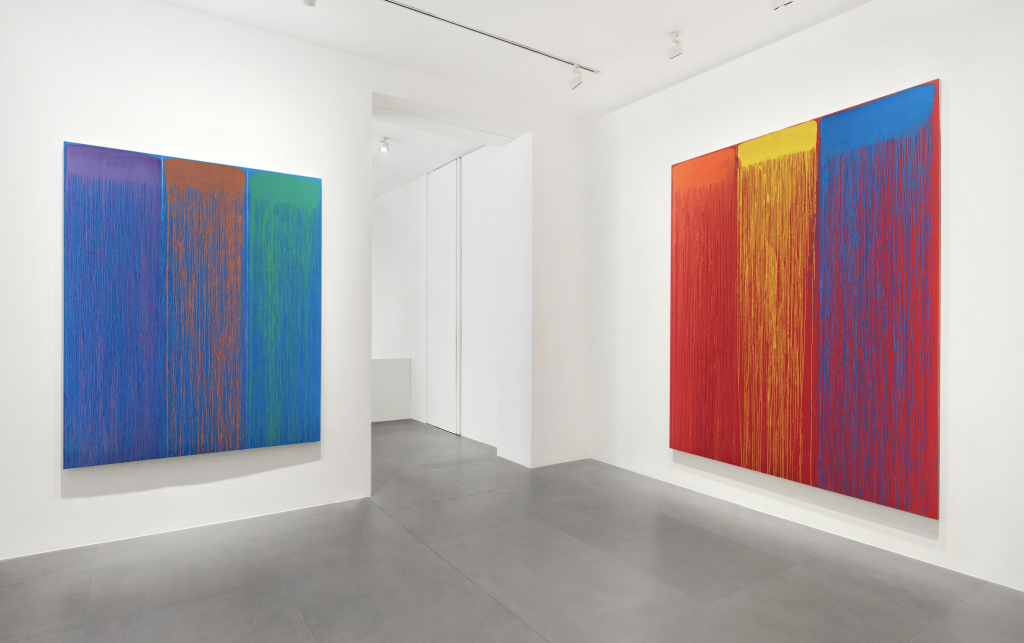
Louise Neri and Pepi Marchetti Franchi, who co-organized "Pat Steir: Paintings," explain what makes the artist tick.

Artnet Gallery Network

Pat Steir is a quintessential artist’s artist. For over fifty years, she has been relentless in her experimentation, blending a process-heavy rigor with a sense of spontaneity.
Steir first emerged on the New York scene in the 1970s with conceptual, often text-based works. By the 1980s she innovated her abstract “Waterfall” paintings, made from a unique process of pouring paint and inspired by Eastern philosophies and the works of John Cage and Merce Cunningham. Over the decades, Steir’s works have become a touchstone for younger generations of artists.
Now, Gagosian Rome is presenting “Pat Steir: Paintings,” the gallery’s first solo exhibition of works by the artist. The recent paintings are a continuation of her “Color Wheel” series (2019), which explored binary color dynamics. The often monumental works on view are made from layering and juxtaposition of vibrant hues often against dark foregrounds.
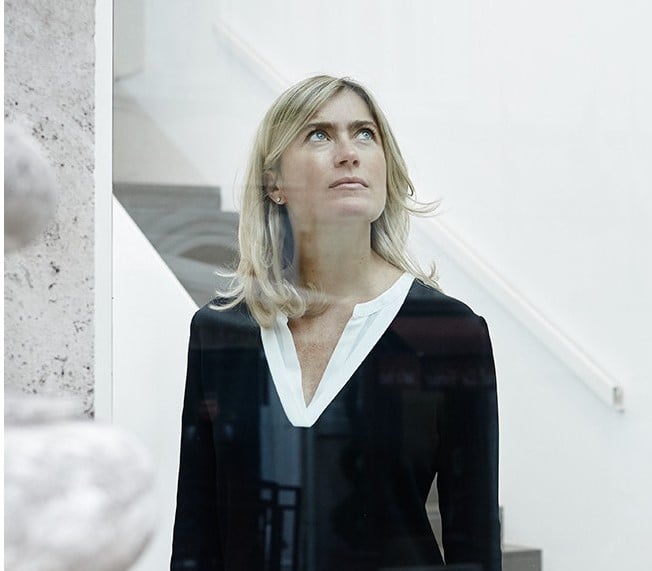
Gagosian Director Pepi Marchetti Franchi. Courtesy of Gagosian.
The exhibition is co-organized by Gagosian directors Pepi Marchetti Franchi and Louise Neri. Marchetti Franchi is the founding director of Gagosian Rome and a member of the gallery’s global advisory board. Since the opening of Gagosian Rome in 2007, she has worked to organize over fifty exhibitions by artists including Cy Twombly, Cindy Sherman, and Richard Serra.
For her part, Neri has been a senior director at Gagosian since 2006 and is a member of the gallery’s global advisory board. She has 40 years of experience organizing exhibitions under her belt and is also an accomplished writer and editor.
We spoke with the two directors about the complex influences at play in Steir’s works and how her works make us see color in a whole new way.
This exhibition is the first solo show of works by Pat Steir presented by Gagosian. Why now? Why in Rome?
Pepi: Pat Steir’s relationship with Italy and its art community goes back a long way—to Germano Celant, Ida Panicelli, and Marilena Bonomo, among others. In 2003, almost 20 years ago and relatively early in her international reception, the Galleria Nazionale d’Arte Moderna in Rome celebrated her work with an important exhibition, “D’acqua e d’aria,” co-curated by Ida Panicelli and Livia Velani.
Louise: My own relationship with Steir goes back to the early 1990s. We have talked about working together for many years. More specifically, Pat had a keen recall of the very special character of our Rome gallery, its spectacular elliptical shape, and the southern light that fills it from full-length windows. She was excited to think about working there.
Pepi: We began discussing the possibility of working on an exhibition several years ago. The pandemic caused inevitable delays but at the end of it all, it was well worth the wait: She produced a powerful and compelling suite of new paintings for the exhibition, some of which derive their vivid colors and titles directly from Rome and its atmospheres. They look even more spectacular in the gallery than we even anticipated!
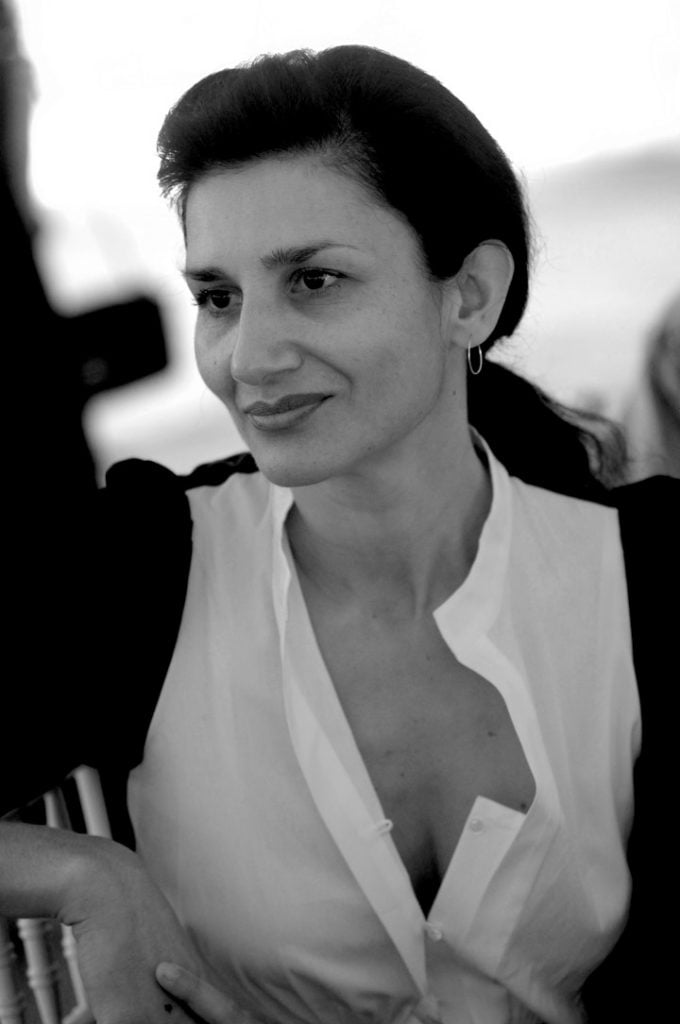
Gagosian director Louise Neri. Courtesy of Gagosian.
Her New York milieu includes Brice Marden, John Cage, Merce Cunningham, and others. What did she have in common with these artists? What set her apart?
Louise: Eastern art and philosophy came together in the ferment of the art scene in 1970s New York, post-Abstract Expressionism—the impact of theory and new forms of conceptual practice, and the implicit rules governing improvisational strategies and spontaneity.
Composer John Cage was especially influential, inspired in his musical work by Buddhist philosophy and the strategy of chance operations and improvisation, which was carried forward by his partner Merce Cunningham in his choreographic practice. This spirit of improvisation became very important to Steir in aiding her to establish a powerful formal structure for her work that nevertheless gave paint its own freedom.
In concrete terms, she participated in an engagement in the discourse of painting, with peers as well as a generation of younger artists, and with critical theory through her editorial work at Semiotext(e), as well as with some of the leading poets of her generation.
Emerging in the 1970s, being a woman artist would have been enough to set her apart from her male peers. Nevertheless, she established many important working relationships with them that endure to this day.
Her works are also strongly influenced by East Asian arts, such as Japanese ink painting and Chinese landscape traditions. How did these interests emerge? How did they transform her work from the text-oriented works of the 1970s to her works in the 1980s?
Louise: In the early 1980s, Steir made her first trip to Japan where she discovered the pure abstraction of ink and brush painting with its performative strokes and splashes and became fascinated with the history of East Asian painting, particularly ancient Chinese shan shui (mountain water) paintings. These cosmic landscapes with mountains and rivers and waterfalls were painted not from direct observation of nature, but from an internalized vision.
Inspired by what she saw, Steir also pursued an intellectual appreciation of the Taoist and Buddhist philosophies that informed these paintings—namely the rejection of the primacy of the self and the relinquishing of total control of one’s medium.
If one thinks about these convergences of Eastern and Western philosophy and aesthetics, fifth-century Chinese paintings and ancient Japanese paintings are radical in their own ways—for example, Japanese culture already had highly abstract forms before abstraction was even a concept in Western painting.
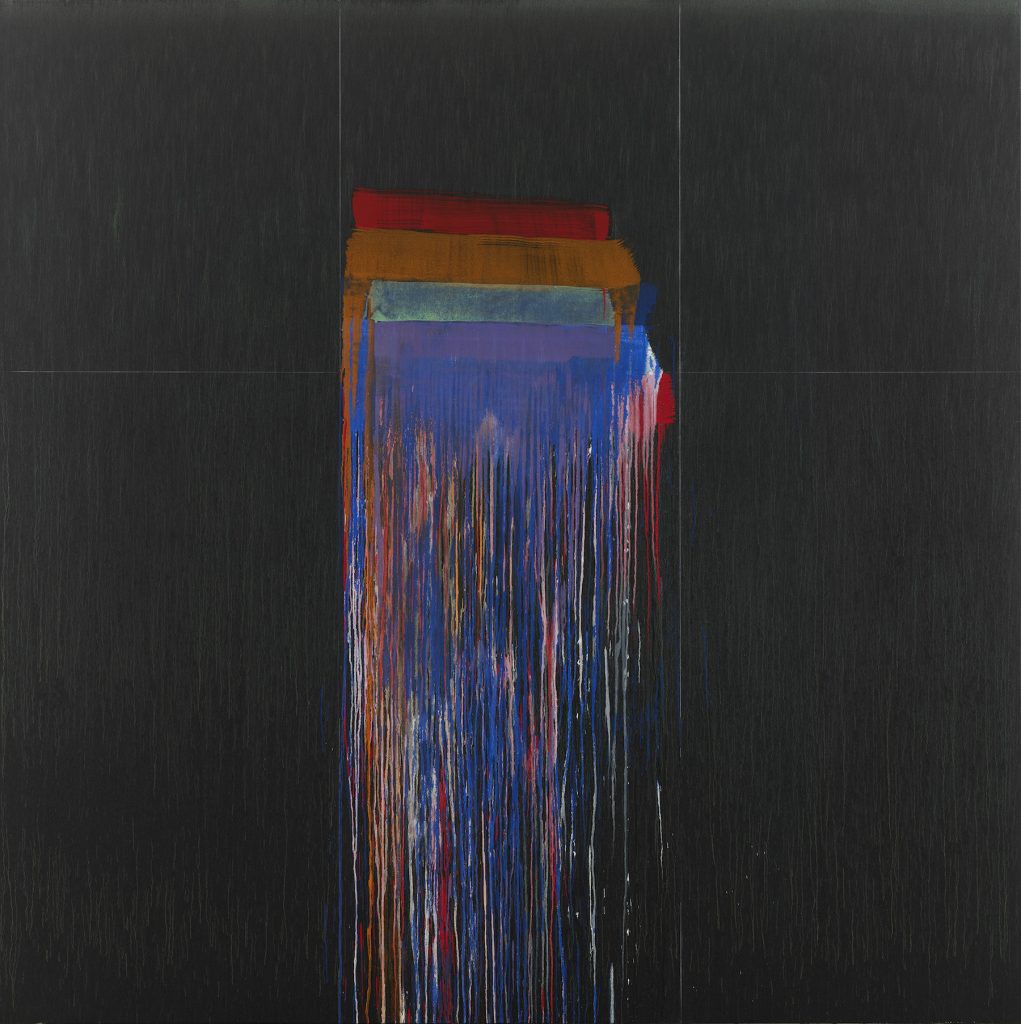
Pat Steir, Winter Daylight (2021-22). © Pat Steir. Photo: Elizabeth Bernstein. Courtesy the artist and Gagosian.
Steir’s painting process is really one of accumulation and layering. Can you talk us through it? Why is it important?
Louise: Oil paint is Steir’s chosen medium and over decades, through experimentation and observation, she has developed a profound understanding of how it behaves. She aligns that understanding to her desire for paint to have its own life.
Taking oil paint, she thins it down, almost to the consistency of ink. First, she builds up the ground, consisting of many sheer layers, over time. This is quite a lengthy process, given the time it takes oil paint to dry. Then the defining moves are made. With Winter Daylight, for example, the first impression from a distance is how dark the surface is, but it is not black as might first be perceived; to the contrary, there are many layers with fine chromatic nuances in the green scale. In considering the time it takes to put down ten or more layers of oil paint, one begins to sense the compression of time emanating from these paintings.
Steir’s paintings are marked by an evident tension deriving from counterpoint—between formality and détente, between predetermination and refusal of control. She comments that while there are a lot of decisions taken to make her paintings, but ultimately the paintings “make themselves.”
In literal terms, she makes bold horizontal strokes on the canvas from which the paint starts to “fall” down the canvas—so the force of gravity is really the invisible agent that completes the paintings. Although she can anticipate to some degree what the painting will do, it’s like trying to predict how water falls.
The press release for the show refers to her process as one of “systematic experimentation”—can you speak to that?
Louise: “Systematic experimentation” refers both to Steir’s particular, practiced method of working with variations on a theme, as well as her mastery of color, which evolved through intensive study of color theory and the dynamics of chromatic counterpoint.
For example, the works on view in Rome extend the systematic experimentations that Steir catalyzed in Color Wheel (2019), a suite of thirty large-scale paintings exploring binary color dynamics, inspired by Newton’s color wheel, the universal visual tool, and reference for anyone interested in the analysis and understanding of our visual reality.
Though artists have employed and recreated the color wheel for centuries, Steir’s interpretation doubles its intensity by including a pour of each color’s exact complement across thirty canvases. The apparent simplicity of each painting’s visual structure is misleading: Each requires the patience to pour five to eleven layers of transparent paint on each canvas, as well as an exacting eye for understanding visual relationships of color.
With each new body of work, Steir deepens her painterly investigations conceptually and formally with regard to the roles of intention and improvisation, process and perception in pictorial structure.
Can you discuss the role of color in her work? How does it relate to her references to seasons as well?
Louise: Steir has always worked in black and white and in color, both vibrant and subtle. In this exhibition, she uses very rich white tones on nuanced black tones, underpainted with other more obscured colors, while referring to a time or day or season… an afternoon, a night, a rainy day. Like Hasegawa Tohaku’s sixteenth-century masterpiece Pine Trees, these could be construed as “winter paintings,” Conversely, there are paintings with dazzling color combinations that evoke the heat of a Roman afternoon, the rainbow after a rainstorm, or the prismatic effects of winter daylight.
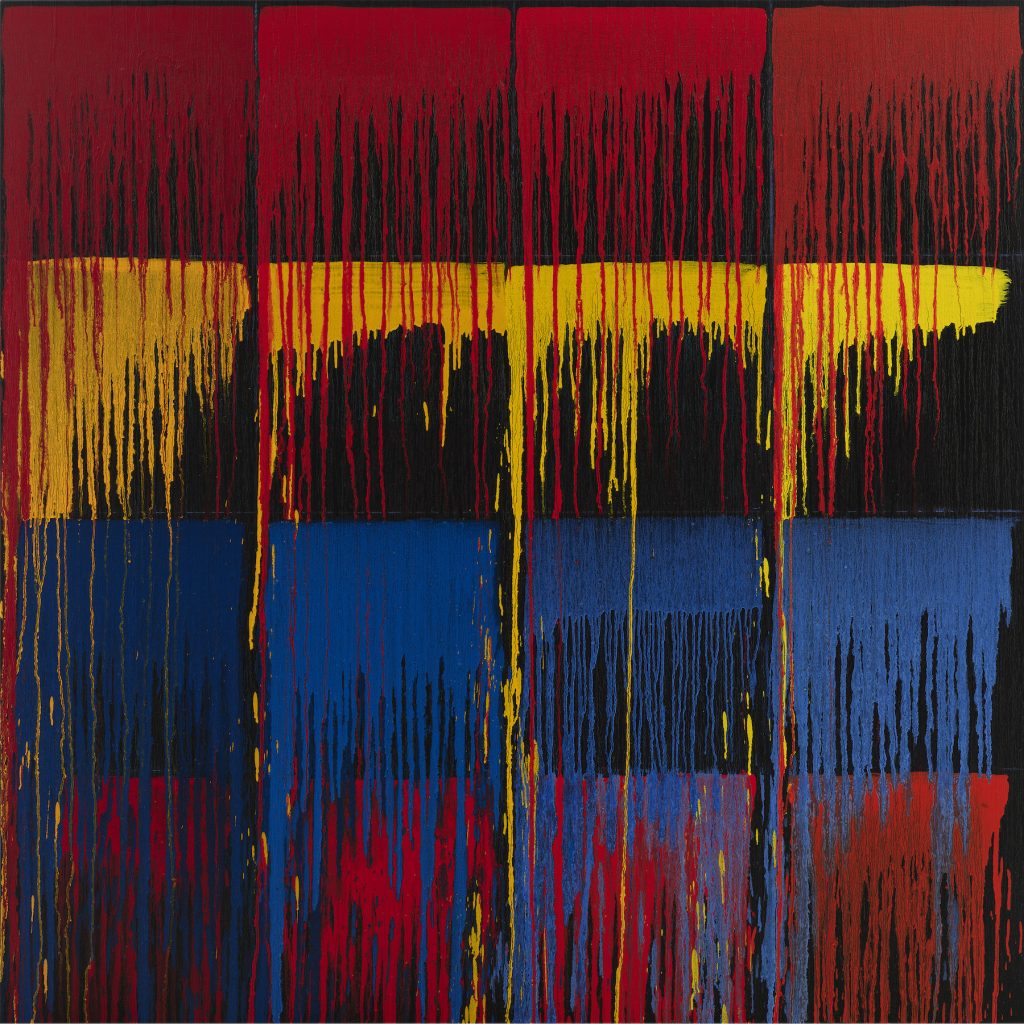
Pat Steir, Small Many (2021-22). © Pat Steir. Photo: Elizabeth Bernstein. Courtesy of the artist and Gagosian.
Is there a work that particularly captivated you in this exhibition? Why?
Louise: It would be impossible to choose just one! My three favorite paintings, One Afternoon, Night, and Winter Daylight have dramatic black backgrounds but are completely different from each other in the ways in which they act on the viewer’s perception.
One Afternoon is a “waterfall” painting where one feels sensorily overwhelmed by an active and totalizing primal force, like a thundering waterfall or a sudden rainstorm. Night is a terse and mysteriously spare partitioned composition with a single motif at human scale, like a musical notation. Winter Daylight is a more recent experiment where the subtly layered background hosts a central motif streaming with glowing colors.
Pepi: One of my favorite works is perhaps the most unexpected. In Small Many, Steir applies seriality to her classic waterfall motif, repeating it sixteen times while conveying very powerful energy within a relatively small scale.
She’s among a group of artists whose significance and influence have only seemed to grow over the decades. Generations of women artists after her have been influenced by her work.
Louise: Steir is an artist’s artist, in dialogue with many artists within and beyond her own generation, past and present. She also maintains close contact with artistic producers across other disciplines—critical theory, poetry, choreography, music—what they are working on and what they are thinking.
Specifically, she has a long-standing collaborative relationship with poet Anne Waldman, she recently collaborated with sculptor Ugo Rondinone on a two-person exhibition, and she is an inspiration for mid-career women artists, such as Sarah Sze and Katharina Grosse.
“Pat Steir: Paintings” is on view at Gagosian Rome through May 31, 2022.